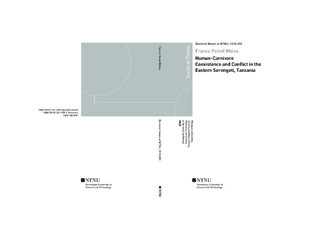| dc.contributor.advisor | Røskaft, Eivin | |
| dc.contributor.advisor | Jackson, Dr. Craig | |
| dc.contributor.advisor | Fyumagwa, Robert | |
| dc.contributor.author | Mbise, Franco Peniel | |
| dc.date.accessioned | 2018-09-04T10:28:45Z | |
| dc.date.available | 2018-09-04T10:28:45Z | |
| dc.date.issued | 2018 | |
| dc.identifier.isbn | 978-82-326-3207-7 | |
| dc.identifier.issn | 1503-8181 | |
| dc.identifier.uri | http://hdl.handle.net/11250/2560659 | |
| dc.description.abstract | In areas where humans coexist with large carnivores, a so called human-carnivore conflict exist due to the carnivores’ natural behaviour of attacking livestock and humans. In northern Tanzania, livestock depredation incidences mostly occurred during the daytime in dry season when livestock are in the pasture. Spotted hyenas were most commonly reported to cause livestock depredation. Most human attacks occurred close to the Serengeti National Park during daytime in wet season while people were herding livestock. Young males were most affected by these attacks because they are responsible of herding livestock. Most human attacks caused injuries rather than loss of life. The predators responsible for these attacks were lions, followed by leopards and hyenas. Financial compensation for lost livestock by predators is not necessarily an effective and sustainable solution. To explore possible alternatives, we tested the willingness of people to coexist with wild carnivores before and after the implementation of a vaccination program to the livestock. This was important in this area because livestock diseases is the most contributing factor to livestock loss. People expressed more willingness to coexist with wild carnivores if they received tangible benefits by living side by side with predators. Therefore, this can serve as an alternative form of compensation. Furthermore, we tested if what people reported to have seen correlated with observations of carnivores in their areas, by conducting carnivore surveys in areas that appeared to have a high probability of encountering carnivore. Our observations matched the reported encounters, confirming the reliability of local people reports concerning livestock depredation and human attacks. The observed and reported frequencies of encountering large carnivores in different areas were negatively correlated with the distance from the park. | nb_NO |
| dc.language.iso | eng | nb_NO |
| dc.publisher | NTNU | nb_NO |
| dc.relation.ispartofseries | Doctoral theses at NTNU;2018:208 | |
| dc.relation.haspart | Paper 1:
Mbise, F. P., Skjærvø, G. R., Lyamuya, R. D., Fyumagwa, R. D., Jackson, C., Holmern, T.,
& Røskaft, E.
Livestock depredation by wild carnivores in the eastern Serengeti ecosystem, Tanzania. International Journal of Biodiversity and Conservation, 10(3), pp. 122-130. (CC BY 4.0)
https://doi.org/10.5897/IJBC2017.1102 | nb_NO |
| dc.relation.haspart | Paper 2:
Mbise, F. P., Skjærvø, G. R., Lyamuya, R. D., Fyumagwa, R. D., Jackson, C., Holmern, T.,
& Røskaft, E.
Attacks on humans vs. retaliatory killing of wild carnivore in the eastern Serengeti ecosystem, Tanzania | nb_NO |
| dc.relation.haspart | Paper 3:
Mbise, F. P., Wanda, J. S., Jackson, C., Fyumagwa, R. D., Lyamuya, R. D., Skjærvø, G. R.,
& Røskaft, E.
Can conservation incentives promote people’s willingness to coexist with large carnivores in the eastern Serengeti ecosystem? | nb_NO |
| dc.relation.haspart | Paper 4:
Mbise, F. P., Jackson, C., Lyamuya, R. D., Fyumagwa, R. D., Holmern, T., Skjærvø, G. R.,
& Røskaft, E.
Do carnivore surveys match reports of carnivore presence by pastoralists? A case of the eastern Serengeti ecosystem | nb_NO |
| dc.title | Human-Carnivore Coexistence and Conflict in the Eastern Serengeti, Tanzania | nb_NO |
| dc.type | Doctoral thesis | nb_NO |
| dc.subject.nsi | VDP::Mathematics and natural science: 400::Basic biosciences: 470 | nb_NO |
